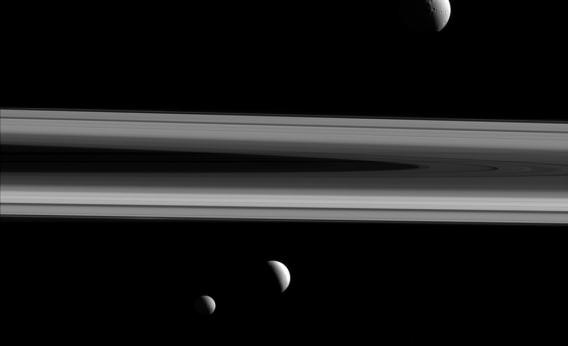Create a free profile to get unlimited access to exclusive videos, sweepstakes, and more!
One Moon, Two Moons, Three Moons, a Trillion Moons

Oh, I love this Cassini image of Saturn’s moons and rings!
It was taken in December 2015, when Cassini was just above the plane of the rings. Saturn’s rings are hundreds of thousands of kilometers across, but from this angle perspective foreshortens them hugely. It’s interesting to see the differing contrast across the rings, the gaps, and the narrow F ring outside the broad main rings.
Those three moons, though! At the upper right is Tethys. Below center is Enceladus, famous for its austral water geysers, and to its left is Mimas, the Death Star moon. Saturn’s moons all orbit very close to the plane of the rings, so again perspective shrinks the view, making it easier to see many moons at once.
Interestingly, they were 1.9 million, 1.35 million, and 1.1 million kilometers from Cassini at this moment, respectively. Sure, Tethys was farther away, but Mimas and Enceladus were roughly the same distance from Cassini, so their relative sizes here are close to their relative physical sizes, too. Mimas appears a wee bigger than it should being somewhat closer, but this gives you a sense of it.
The moons are 1,110, 500, and 400 kilometers across, respectively. So really, Tethys is more than twice the diameter of Enceladus. Even then, though, it’s not huge; our own Moon is three times wider.
While our Moon is made of rock, each of those three moons is pretty low density, indicating they’ve got a lot of water ice; if they were predominantly rocky, they’d be much denser.
Funny, too: The rings are made of countless chunks of ice themselves, so small they blend into a smooth whole as seen from this distance. So you’re seeing far more than three moons here; you’re seeing trillions!
Depending on how you define moon, of course. Either way, it’s a lovely image, and a reminder that alien worlds are in our own backyard. Exploring them yields a bounty of scientific benefits, but also broadens our minds. That’s worth the effort.














